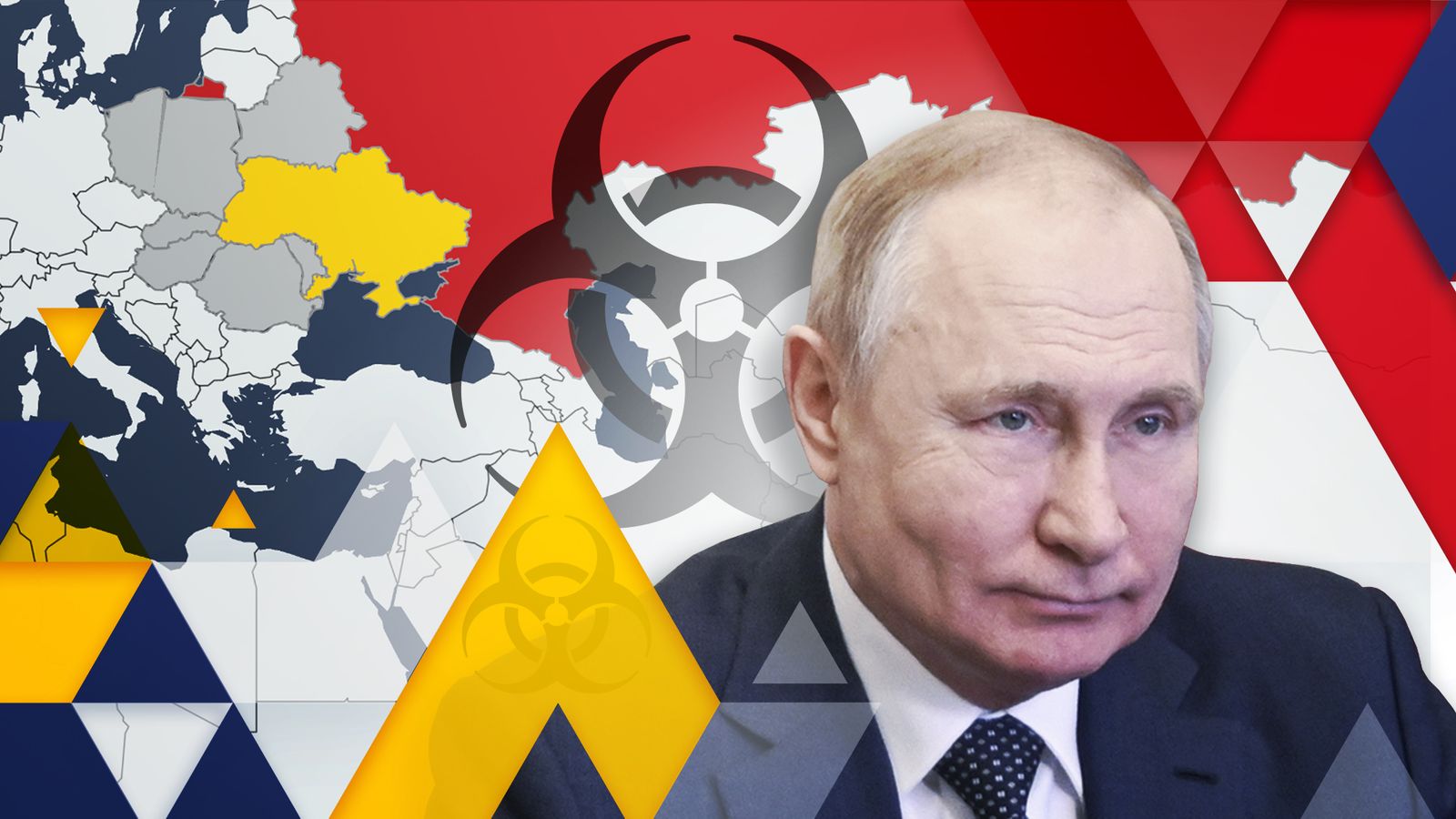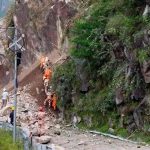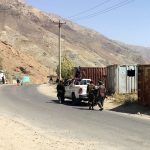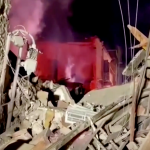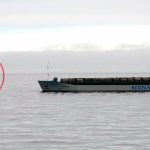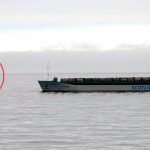UK and US intelligence officials have warned there is “serious concern” Russia could use chemical or biological weapons in Ukraine.
Western allies have accused President Vladimir Putin and his forces of planning a “false flag” operation, which would use a false claim that Ukraine has such weapons as an excuse for Russia to deploy its own.
Prime Minister Boris Johnson described the strategy as “straight out of their playbook”, as it is the same one Russian-backed Bashar al-Assad used for carrying out chemical attacks during the civil war in Syria.
Please use Chrome browser for a more accessible video player
Here Sky News takes a closer look at Russia’s history of using chemical weapons – and what it could be planning to use now.
Why does the West think Russia will use chemical weapons in Ukraine?
Although it is signed up to the 1997 Chemical Weapons Convention, which bans it from developing, using or stockpiling them, Russia is still known to have used them.
Pentagon and Ministry of Defence intelligence chiefs have repeatedly warned the Kremlin is fabricating claims Ukraine and its Western allies have chemical or bioweapons.
They say Mr Putin wants to use that as justification for using similar weapons on the Ukrainian people. Russia first started making these accusations last year – before the invasion.
On 21 December, Russian defence minister Sergei Shoigu said there were 120 US mercenaries in the occupied Donbas region of east Ukraine that had been given “tanks of chemicals to commit provocations”.
One week into the conflict on 3 March, his colleague foreign minister Sergei Lavrov said US intelligence officials were worried fighting could result in its chemical and biological facilities there being damaged.
The US has no chemical or biological facilities inside Ukraine – it just helps it safeguard its non-military biological laboratories.
On 9 March, a spokesperson for Mr Lavrov’s department said it had discovered a military biological weapons programme inside Ukraine, with labs in Kyiv, Kharkiv and Odesa investigating how to use bats and birds to spread deadly pathogens such as anthrax.
But Dr Brett Edwards, senior lecturer in public policy and security at Bath University, told Sky News: “There are labs in Ukraine, which have been there since before the Cold War, but they are registered, legitimate laboratories, there’s nothing shady about them.”
The US dismissed the claims as “absurd propaganda”, for which there is zero evidence.
In his latest daily address, Ukrainian President Volodymyr Zelenskyy added: “No chemical or any other weapons of mass destructions were developed on my land. The whole world knows that.”
Chemical weapons use chemicals with toxic properties to intentionally cause death or harm.
They are categorised by the effect they have on the human body.
Nerve agents stop people’s nerves sending messages to their muscles and result in paralysis and loss of bodily function.
Types of nerve agents include sarin, used in Syria, Novichok, used in the Salisbury and Navalny poisonings, soman and tabun.
Blistering agents come in gas, aerosol or liquid form and cause the skin to blister on contact. Examples include sulphur mustard, used in the First World War and nitrogen mustard.
Choking agents cause respiratory failure if they are inhaled or digested. The main one used in the past has been chlorine.
Blood agents affect the body’s ability to send oxygen through the blood stream, with examples including hydrogen chloride and cyanogen chloride.
Biological weapons – or bioweapons – are ones that deliberately spread viruses, bacteria, fungi or toxins in order to cause death or harm.
Examples include:
Anthrax, a serious bacterial disease previously used as a means of bioterrorism. It can be deadly and results in skin sores and vomiting.
Botulinum toxin, a bacteria that produces a toxin which blocks people’s nerves and can result in respiratory and muscular paralysis.
Plague, caused by bacteria, has been used by countries in the past as a bioweapon.
When has Russia used them before?
During the Second Chechen War, in October 2002 Russian troops used a gas containing the opioid carfentanil after Chechen rebels stormed a Moscow theatre and took people hostage.
The substance – 10,000 more powerful than morphine – killed 120 of the hostages.
Two years later in 2004 toxicologists found that Ukraine’s pro-Western president Viktor Yushchenko had been poisoned by the chemical TCDD.
Mr Yushchenko, who had beaten Mr Putin’s preferred candidate Viktor Yanukovych in the elections that year, claims the attack was carried out by Russia.
The widest-scale example of Russia using chemical weapons was in Syria, where it fought alongside Bashar al-Assad’s government forces in the country’s civil war.
Studies estimate there were 85 chemical weapon attacks during the war.
Syria forms a key part of Russia’s so-called “playbook”, as each time an attack was carried out, President Assad would say terror groups ISIS and Al-Qaeda had the weapons first.
Follow the Daily podcast on Apple Podcasts, Google Podcasts, Spotify, Spreaker
Dr Edwards, an expert in the history of chemical and biological weapons, said: “It all comes back to Syria. Russia lied repeatedly about there being chemical weapons in Syria, while working hand in hand with a Syrian regime that was using chemical weapons. In that context, we know Russia lies on these issues.”
The worst attack in Syria was in the Damascus suburb of Ghouta in August 2013 when up to 1,700 people died as a result of the nerve agent sarin.
People tried to escape from their homes only to collapse, foaming from their mouths and noses, and suffocate to death.
After the atrocities in Ghouta, the Russians agreed to negotiate with the US on behalf of President Assad and eventually struck a deal to allow them to destroy Syria’s illegal stockpile of chemical weapons.
During the operation, US officials found about 1,300 tons of mustard gas and the nerve agents sarin and VX.
But despite Syria joining the Chemical Weapons Convention that year, chlorine and other chemical weapons were still used numerous times by Russian-backed Assad forces.
Russia has also repeatedly used chemicals to poison wanted individuals abroad.
In November 2006, former KGB officer-turned British spy Alexander Litvinenko was poisoned by Russian agents in a London hotel.
They contaminated his tea with the highly radioactive chemical polonium 210.
He died of acute radiation poisoning three weeks later.
In March 2018 former Russian military officer Sergei Skripal, who had also turned spy for the British, was poisoned with the nerve agent Novichok alongside his daughter Yulia in Salisbury.
Both survived the attack, but two others – Dawn Sturgess and Charley Rowley – came into contact with the same nerve agent via a contaminated perfume bottle months later seven miles away in Amesbury. Ms Sturgess died almost instantly, but Mr Rowley survived.
The dose found on the perfume bottle is thought to have been strong enough to harm 10,000 people.
Most recently in August 2020, Russian opposition leader Alexei Navalny fell ill on a flight home to Moscow after being poisoned with Novichok.
After receiving treatment in Berlin five certified laboratories confirmed the use of the nerve agent.
What weapons does Russia have – and what could they use in Ukraine?
Asked about the prime minister’s “playbook” warning of a potential chemical weapons attack in Ukraine, former British intelligence officer Christopher Steele told Sky News he “wouldn’t rule it out at all”.
He said: “I think as the Russian army becomes bogged down and clearly not realising its objectives militarily, you are likely to see more indiscriminate killing and bombardment and possibly the use of chemical weapons.”
Read more:
What is the Wagner Group of ‘secret’ Russian mercenaries?
What are cluster and vacuum bombs – and do they break international law?
But Dr Edwards says that Russia being a signatory of the Chemical Weapons Convention (CWC) means it does not have the capacity to launch chemical attacks like the ones seen in Syria.
“The CWC is the most intrusive and successful disarmament convention we have,” he tells Sky News.
“Because of its collaboration with the CWC, Russia is subject to on-site inspections and investigations.
“So we know they don’t have major stocks, because they’ve either been destroyed or are in the process of being destroyed.”
Dr Edwards also claims there would be more widely-available intelligence if such weapons were being mobilised in Ukraine.
“We’d see it in the intelligence, it’s a whole infrastructure, so we’d see specialist units moving it all – which we haven’t.”
But he says Russia could be producing chemical weapons on a smaller scale.
“The smaller use of weapons – akin to terrorism – is more likely,” he explains.
“The CWC can’t capture smaller, clandestine production. And we have good reason to assume there is small-scale production of nerve agents in Russia – but that doesn’t have any relationship with the tonnes needed for chemical warfare.
“It’s nowhere near on the scale the West has been talking about.”
On bioweapons, he said there is “little reason to believe” Russia has the capability or intent to use them. But he fears incapacitants – such as tear gas and opiate-based substances – could be used to cause harm on a wide scale.
“Russia is very likely to use tear gas in a way that violates people’s human rights – and there are also concerns other incapacitants could be used in the same way,” he says.
“We should be as worried about that as we are chemical weapons.”
